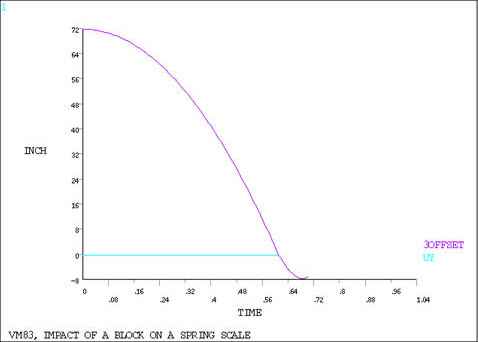VM83
VM83
Impact of a Block on a Spring Scale
Test Case
A block of weight WB is dropped from a height h onto a spring scale pan of weight WP. Determine the maximum deflection δ of the pan and the maximum fall of the block y. Assume the impact to be perfectly plastic as a theoretical approximation.
| Material Properties | Geometric Properties | Loading | |||||
|---|---|---|---|---|---|---|---|
|
|
|
Analysis Assumptions and Modeling Notes
The mass of the block (mB) and the mass of the pan (mP) are calculated as mB = WB/g = (50/386) lb-sec2/in and mP = WP/g = (25/386) lb-sec2/in respectively. Deflection of the pan due to gravity is WP/k1 = 0.25 in, hence the initial gap becomes (72-0.25) = 71.75 inches.
The spring length is chosen arbitrarily. The closed-gap spring constant (k2 = 10,000 lb/in) is arbitrarily selected high enough to minimize the elastic contact effect but low enough to also allow a practical integration time step size. The integration time step (0.0005 sec) is based on < 1/30 of the period of the contact spring to minimize the numerical damping effect, and to allow the acceleration change to be followed reasonably well.
Automatic time stepping is used to reduce the total number of iterations needed to solve the problem. A static solution is done at the first load step to produce the initial pan condition before the start of the transient analysis. The maximum time of 0.7 sec allows the pan to reach its largest deflection.
To model the "plastic impact" a damper (C2) is used which has the value of critical damping to prevent oscillation of the contact spring. Also, the two masses are locked together after initial contact by use of KEYOPT(1) = 1 on combination element type 1 (COMBIN40). Natural frequency of the closed gap is f2 = sqrt(k2mp)/(2 π) = 62.54 Hz. Critical damping is calculated as C2 = k2/πf2 = 10000 / (62.54 π) = 50.90 lb-sec/in. POST26 is used to extract results from the solution phase.
Results Comparison
| Time = 0.689 sec | Target | Mechanical APDL | Ratio |
|---|---|---|---|
| Deflection, in | -7.7000 | -7.6135 | 0.989 |
| y, in | -79.450[1] | -79.414 | 1.000 |



